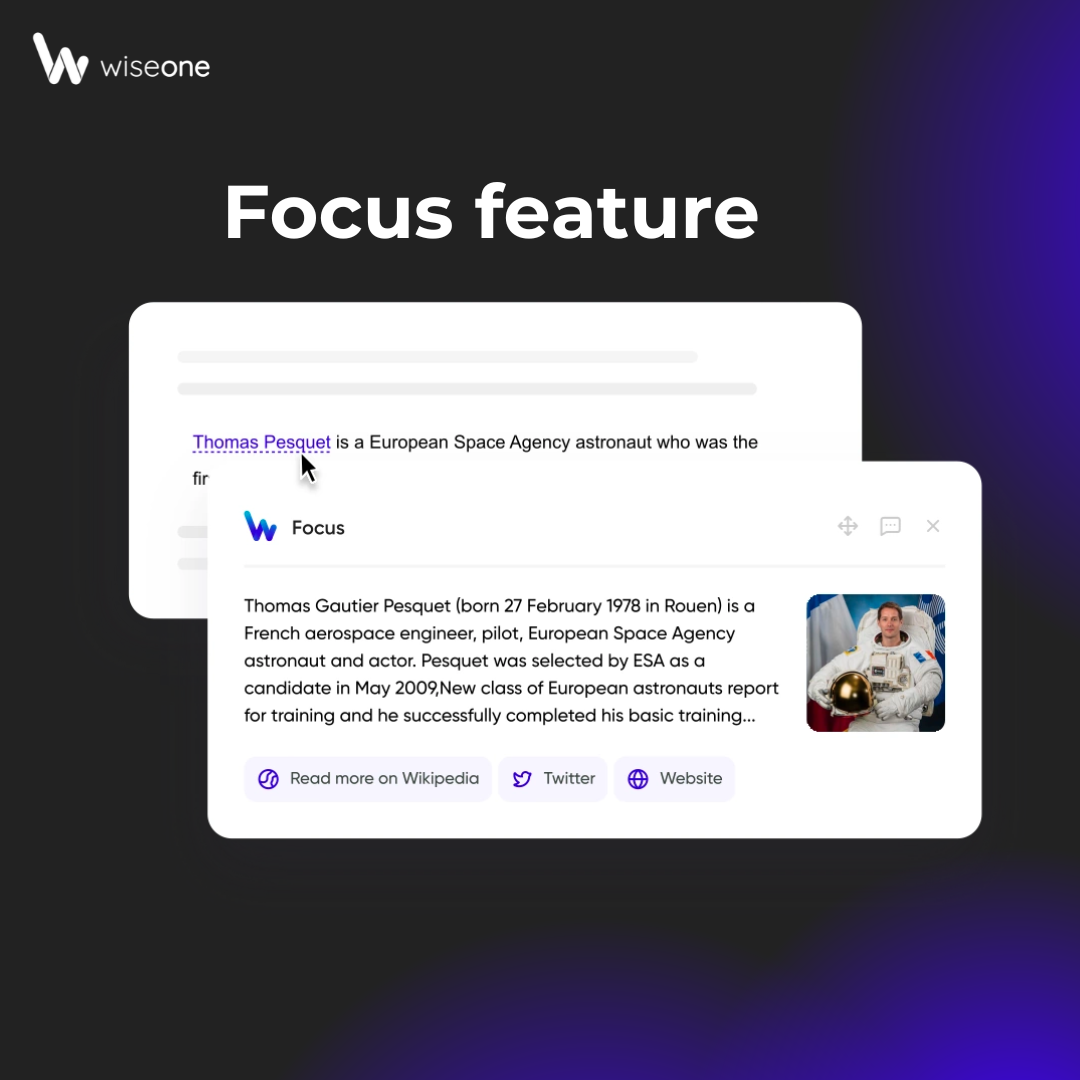Wiseone's 'Focus' feature: a deep dive

Introduction
Among AI reading tools, Wiseone truly stands out with its six distinctive features. Today's article will delve into the AI behind the “Focus” feature and unravel the mechanisms that drive its functionality.
Regarding Focus, three innovative techniques are pivotal in the feature: Named Entity Recognition (NER), Entity Linking, and Coreference Resolution.
Each technique addresses a unique facet of language understanding, from identifying specific entities within the text to linking them with a knowledge base and resolving complex reference relationships.
Let's learn these techniques and discover how they work in harmony, allowing Wiseone's Focus feature to seamlessly provide an understanding of complex concepts and words.
What is the 'focus' feature?

Wiseone's focus feature allows you to understand 100% of what you are reading, ensuring you never encounter unfamiliar words that significantly impact your overall understanding of a subject.
"Focus" helps you easily understand complex words—whether they refer to an organization, a concept, or a person. The feature provides a suitable definition and access to crucial information, such as websites, articles, financial information, or social media links.
The AI behind the 'focus' feature
Named Entity Recognition
NER is often abbreviated as NER. It is a fundamental natural language processing (NLP) technique that helps understand and extract information from textual data.
At its core, NER involves identifying and classifying named entities within a text, typically real-world objects such as names of people, organizations, locations, dates, numerical values, and more.
By automatically recognizing these entities, NER systems contribute to various tasks, including information retrieval and question-answering sentiment analysis.
The NER process involves analyzing the grammatical and semantic features of words within a sentence to determine their entity type; the analysis consists of distinguishing between common words and proper nouns and subsequently categorizing the entities into predefined classes.
As NER technology advances, it promises to enable more accurate and efficient information extraction, enhancing the capabilities of a wide range of NLP applications.
Entity Linking
Another component of natural language processing (NLP) is entity linking, a sophisticated technique that enriches textual data by connecting named entities to their corresponding entries in a knowledge base or database.
The primary goal of entity linking is to disambiguate and contextualize mentions of named entities in a given text, linking them to specific entities in a structured knowledge source, such as Wikipedia, Freebase, or DBpedia.
This process not only aids in disambiguation (resolving multiple possible meanings of an entity) but also enhances understanding by associating entities with additional information stored in a database.
Entity linking involves processes such as:
- Candidate generation (identifying potential matches),
- Candidate ranking (choosing the most appropriate match),
By successfully implementing entity linking, NLP systems can provide users with more informative and contextually relevant results, making information retrieval, question answering, and other tasks more precise and valuable.
With NLP technology evolving, entity linking becomes a crucial bridge between unstructured text and structured knowledge, enhancing NLP solutions' overall accuracy and utility.
Coreference Resolution
Coreference resolution is a vital aspect of natural language processing (NLP).
It tackles the challenge of determining when different words or phrases within a text refer to the same real-world entity.
Coreference resolution aims to link these expressions to a common entity, enriching the text's coherence and clarity.
This process is essential because, in language, it's common to use pronouns, definite nouns, or other expressions to refer back to entities previously mentioned.
An effective coreference resolution algorithm enhances understanding of relationships and context within content, facilitating more accurate interpretation and analysis. The technology involved in coreference resolution leverages linguistic and contextual cues to identify instances where co-referential relationships exist.
This task often involves complex linguistic phenomena, such as anaphoric and cataphoric references, and bridging references that connect entities across sentences. By successfully resolving coreferences, NLP systems can create a more unified representation of the information contained in a text, which in turn benefits information extraction, document summarization, and content translation.
How does Wiseone's focus work
Wiseone's "Focus" feature helps you understand complex concepts and words on any webpage, enabling you to master 100% of your reading.
Wiseone's feature in action
The AI-powered feature operates by Wiseone meticulously analyzing the HTML code of a webpage, detailing the core article content while disregarding irrelevant elements like advertisements and user comments.
The process unfolds in three distinct stages:
Language Identification
Initially, Wiseone identifies the language of the article content.
Named Entity Determination
This is where named entity recognition plays a pivotal role. It consists of scanning through the content to ascertain which words are complex and require an understanding from online readers.
For instance, the feature prioritizes explaining terms like "cognitive dissonance" over more common, easy-to-understand words like "Television."
Wiseone's algorithms also enhance the ability to recognize words and complex concepts.
Precise Abstract Provision
Following identifying complex words and terms, Wiseone provides accurate abstracts for the underlined words.
Focus’s definitions are sources from the internet’s most prominent websites, such as Wikipedia, LinkedIn, and Crunchbase.
In some cases where the concept's information is absent, Wiseone expands its search across other platforms.
An interesting scenario arises with homonyms, such as "Apple," which could refer to the fruit or the technology giant.
Wiseone's algorithms base the answers on the context. If the article pertains to the latest iPhone model, the definition of "Apple" would pertain to the technology company. Conversely, if the context revolves around a recipe for apple pie, the description would relate to the fruit.
In addition to supplying definitions, Wiseone's focus feature augments its responses with supplementary information from social media platforms like Twitter and LinkedIn, websites such as Crunchbase, and company webpages.
Conclusion
Wiseone's "Focus" feature is a powerful tool for bridging the gap between complex content and reader comprehension.
We've explored how Named Entity Recognition (NER), Entity Linking, and Coreference Resolution harmoniously contribute to the focus feature's functionality.
NER, a cornerstone of text analysis, extracts meaningful entities from text, enhancing tasks ranging from sentiment analysis to machine translation. Meanwhile, Entity Linking adds depth to the understanding by connecting these entities to vast knowledge bases, enriching their context.
Coreference Resolution, on the other hand, untangles the intricate web of references, leading to a more transparent and coherent narrative.
The feature ensures a comprehensive understanding of complex terms by dissecting web page content through stages of language identification. Its nuanced approach to homonyms and reliance on context ensures readers access to accurate definitions tailored to the topic, with supplementary information from many sources, including social media and reputable websites.
Wiseone's "Focus" feature exemplifies the potential of AI-driven tools in enhancing language comprehension and fostering a more profound engagement with written content.
FAQ
What is Wiseone?
Wiseone is an AI-powered browser extension that allows individuals and professionals to improve the productivity of their search and online reading uniquely and innovatively.
The AI tool was created with the idea that we live in a world of information overload and misinformation and that a technological solution leveraged by AI will be the answer to help web users be more efficient and productive in the way they consume information online.
Every feature in the browser extension is designed to save you time, expand your knowledge, and boost your productivity using the best LLMs available today.
What is the 'focus' feature?
Wiseone's 'focus' feature allows you to understand 100% of your reading, ensuring you never encounter unfamiliar words that significantly impact your overall understanding of a subject.
"Focus" helps you quickly understand complex words—whether they refer to an organization, a concept, or a person. The feature provides a suitable definition and access to crucial information, such as websites, articles, financial information, or social media links.
How does Wiseone's focus work?
The AI-powered feature operates by Wiseone meticulously analyzing the HTML code of a webpage, detailing the core article content while disregarding irrelevant elements like advertisements and user comments.
The process unfolds in three distinct stages: Language Identification, Named Entity Determination & Precise Abstract Provision.
What is the AI behind the 'focus' feature?
The AI behind Wiseone's 'focus' feature includes Named Entity Recognition, Entity Linking & Coreference Resolution.
How to download Wiseone?
To enhance your web search and online reading experience, follow these simple steps to start using Wiseone:
- Visit the Chrome Web Store and click on 'Add to Chrome'.
- Once the extension is added, create an account at https://app.wiseone.io/
- We recommend watching Wiseone's tutorial video. The brief yet insightful video presents how to use the AI tool and its features.
How to use 'Focus' feature?
After downloading the extension, you can hover over any complex word, and Wiseone will provide a suitable definition.
Enhance your web search,
Boost your reading productivity with Wiseone



